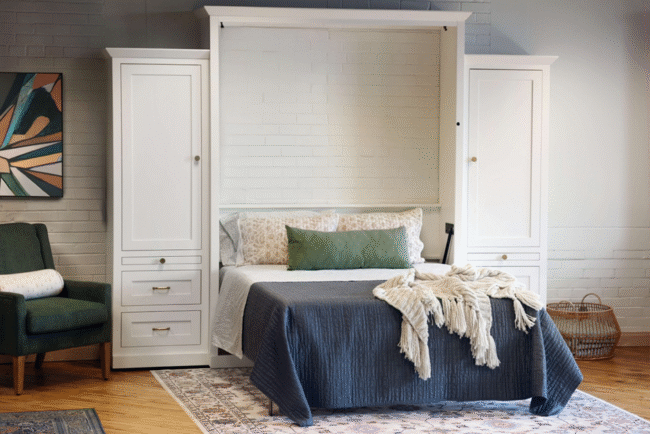If you’re like me, your guest room is actually used by guests maybe five nights a year and for laundry piles the other 360. But wouldn’t it be great if you could throw in a Murphy bed and get a space that can be an office on weekdays and a workout zone on weekends, while still remaining a decent place for visitors?
Reach out to Legacy Handcraft if you’re serious about space-saving furniture built from real wood. I’ll share what I wish I’d known before I made the change and the small design choices that make a big difference once the bed is on the wall and real life begins.

Space Equals Calm
There’s a reason a room that breathes feels better. Environmental psychology has a growing body of research linking cluttered, visually busy homes with higher stress levels.
One well-known study followed families and found that people who described their homes as cluttered showed cortisol patterns associated with more stress and lower mood over the day. So, freeing up floor and wall space isn’t just cosmetic; it can help your brain downshift.
That doesn’t mean you need a minimalist white box. But, reclaiming the footprint of a traditional bed, while still having a real mattress when you need it, changes the whole vibe of a room.
Why Not Just a Sofa Bed?
I’ve owned both a sofa bed and a Murphy. The former is usually fine for one night, and then it turns into a chiropractor’s marketing brochure. With a Murphy bed, you’re using an actual mattress with your choice of firmness and a real bed frame that disappears vertically.
There are also no nightly engineering projects to convert it. The mechanism stays put, and the mattress doesn’t fold like origami, which means even the bedding can stay on.
You’ll also get a visual reset. When the bed is up, the room looks like a studio or office, and when it’s down, it feels like a proper bedroom. That mental switch is underrated, especially if you work from home and need your office not to stare at you at midnight.
What I Wish I’d Known Before Buying
Go for solid wood. Particle board can look okay in photos, but the moment you start using the bed daily (or even weekly), you’ll feel the difference. Solid wood hardware mounting means a stable frame, and proper brackets mean less creaking and a longer life.
Most systems require you to fix the cabinet to studs or masonry. Hit the studs, use the recommended lag bolts, and don’t skip the torque checks. If you’re even mildly unsure, hire out the install.
The mechanism should be quiet and balanced. Gas pistons or counterbalanced springs should make the bed feel light to lift and controlled on the way down. If it slams or you have to muscle it, either the mechanism is low-quality or it wasn’t installed/tensioned correctly.
Leave enough clearance for side tables and a path to the door. Tape the perimeter on the floor before you buy so you can “feel” the footprint.
Style Choices That Make the Room Work Harder
My biggest win was pairing the bed cabinet with built-in floating shelves to keep the floor clear. A clear floor makes cleaning easier and visually calms the room with uninterrupted lines rather than lots of short, busy ones.
Lighting is the second quiet hero. Put warm, dimmable sconces on the cabinet or on the wall beside it. In “office mode,” they act as soft background light. In “guest mode,” they’re good reading lights that don’t blast the room.
And don’t ignore fabric. If your Murphy bed lives in a room with a window, the way the drapery hangs can either crowd the wall or make the ceiling feel taller. If you’re unsure which header style will look neat when the bed is closed, here’s a quick primer on curtain headings to help you choose something crisp that won’t compete with the cabinet.
Final Thought
A Murphy bed is much more than just a clever trick. It’s a way to turn a once-a-year guest room into the most flexible square footage in your home. Pair it with clean wall storage and smart fabric choices, and your space will finally look as good as you always hoped it would.
